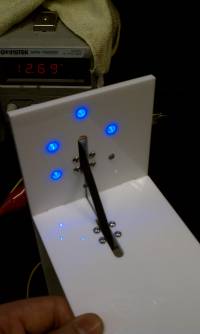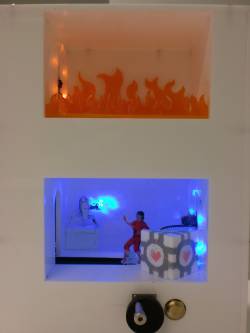Timeline for the Automata Design
March 11
- ✔ Design the movement mechanism
- ✔ Find a motor to power the LEDs.
- ✔ Verify that enough power can be generated in order to run the LEDs (about 10 of them)
March 18 (Spring Break)
- ✔ Finish CAD of the design
- ✔ Have all electronic components to be used in the motor-LED system
- (now considering using a battery-powered system as a motor-powered system might require more torque and speed than can be feasibly delivered by the handcrank)
March 25
- ✔ Have mechanical components ordered
- ✔ Have a scheduled time with the lasercutter for following week
- (multiple appointments will be required. one set of components has been cut)
- ✔ Have a scheduled time in the machine shop for following week
- (wednesdays, midday works for the majority of the team and is general use time for the shop)
April 1
- ✔ Have finished lasercut parts
- testing needs to be done to make sure that laser cut parts are in fact usable. more cutting needs to be done.
- ✔ Have several (hopefully all) manufactured parts
- there are very few manufactured parts. most machining consists of modifying the existing musicbox.
April 8
- ✔ Assemble and test the design
Subsequent Weeks
- Modify design to improve testing
Detailed Progress
- March 4:
- Andrew and Mike P found a motor and tested that with a moderate-speed turn of the rotor, the generator was able to light one LED
- March 7:
- Andrew and Mike P determined that the generator was sufficient to power at least 7 simultaneous LEDs.
- March 10:
- Full team met to design the movement system and to make determinations with regard to the finalized idea of the project.
- March 24:
- Full team met to prepare a CAD model of the entire system. This is thus far, a preliminary design to be modified in the upcoming week, and to have components tested before the final product is designed.
- March 29-31:
- Andrew and Mike P modify the CAD to reflect testing that was done. Matt prepared a model of the female character from Portal, and will find remaining material needed to build the automata. Mike S prepares the music to be played and searches for a musical comb that contains the 6 notes needed for the song to play.
-
- Thus far, we have lasercut a number of components and have started machining and tapping. Our primary need is to obtain a musicbox, as most of our interlocking mechanisms are contained within it. Most of future manufacturing for the car requires use of the machine shop, as almost all of the lasercut parts are either already cut or will be ready to be cut soon.
- Viewable in the pictures and the video, are two of the lasercut components and 4 LEDs. The LEDs are meant to be behind the portal that leads to the flames, and the triangular placement of the timing belt is intended to be used as a path for the cake. To view a video of what we have so far, click here.
- April 14
- Full team worked to machine the aluminum musicbox to desired specifications (one mistake was made that, until corrected, will render the musicbox unable to enact full motion), and to lasercut all parts before first attempt at assembly. Needed corrections include enlarging clearance holes to allow for misalignment of holes, milling one slot in the aluminum box to allow a belt to pass through, re-tap one of the holes to allow the axle to pass.
- The electrical system was fully designed, with calculations for the entire circuit assuming a 9V input. Because a motor would create the need to exert a very high torque, it will probably be better to just power the LEDs off a battery.
- April 21
- The team met to attempt a finished assembly. Some problems lingered, so the final assembly is left for next week.
- April 28
- The automata was fully assembled and worked correctly, with the exception of the lower cake. There was not enough clearance for the cake to move with the axle, so the lower deck was redesigned to remove the axle. Also, the music system was change from a pin system to a paper system (google “Mechanical Music Box”).
- May 5
- The team met once again to finish making the new changes that needed to be established and generated a completed music box with the finalized automata, as can be seen in the picture to below.
Except where otherwise noted, content on this wiki is licensed under the following license:CC Attribution-Noncommercial-Share Alike 3.0 Unported


